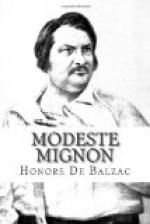The young man would have seemed to a student of French history a very fair representative of the royal and almost inconceivable figure of Louis XIII.,—that historical figure of melancholy modesty without known cause; pallid beneath the crown; loving the dangers of war and the fatigues of hunting, but hating work; timid with his mistress to the extent of keeping away from her; so indifferent as to allow the head of his friend to be cut off,—a figure that nothing can explain but his remorse for having avenged his father on his mother. Was he a Catholic Hamlet, or merely the victim of incurable disease? But the undying worm which gnawed at the king’s vitals was in Ernest’s case simply distrust of himself,—the timidity of a man to whom no woman had ever said, “Ah, how I love thee!” and, above all, the spirit of self-devotion without an object. After hearing the knell of the monarchy in the fall of his patron’s ministry, the poor fellow had next fallen upon a rock covered with exquisite mosses, named Canalis; he was, therefore, still seeking a power to love, and this spaniel-like search for a master gave him outwardly the air of a king who has met with his. This play of feeling, and a general tone of suffering in the young man’s face made it more really beautiful than he was himself aware of; for he had always been annoyed to find himself classed by women among the “handsome disconsolate,”—a class which has passed out of fashion in these days, when every man seeks to blow his own trumpet and put himself in the advance.
The self-distrustful Ernest now rested his immediate hopes on the fashionable clothes he intended to wear. He put on, for this sacred interview, where everything depended on a first impression, a pair of black trousers and carefully polished boots, a sulphur-colored waistcoat, which left to sight an exquisitely fine shirt with opal buttons, a black cravat, and a small blue surtout coat which seemed glued to his back and shoulders by some newly-invented process. The ribbon of the Legion of honor was in his buttonhole. He wore a well-fitting pair of kid gloves of the Florentine bronze color, and carried his cane and hat in the left hand with a gesture and air that was worthy of the Grand Monarch, and enabled him to show, as the sacred precincts required, his bare head with the light falling on his carefully arranged hair. He stationed himself before the service began in the church porch, from whence he could examine the church, and the Christians—more particularly the female Christians—who dipped their fingers in the holy water.




